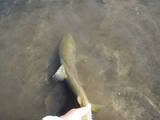The DWR coating needs replenished periodically if your waders no longer have water bead on them. Now is the time of the year you want to make sure you have no leaks and that your waders are functioning properly. Unintentionally wet wading the Owens (or any other river for that matter) in December and January can be unpleasant.
Simms has a good video on how to correct simple wet out.
http://www.bluequillangler.com/Customer-Service/Renewing-the-DWR
Simms uses Revivex, but I prefer Nikwax products which seems to last longer and is simpler to use. You can purchase Nikwax products from Sierra Trading Post online and I know Revivex can be purchased through Amazon. I'm sure other places sell each of the products as well.
What brings this up, you say? Yesterday when I stepped into my Idaho local, I suddenly felt cold water on my left foot as the water was a brisk 51.9 degrees and outside air temp was 39. Not a good sign as I had just worn these waders for 4 days fishing local rivers a week ago and stayed dry the whole time. I came to fish, so I fished all day, but obviously had to repair these waders soon. Unfortunately I didn't have a backup pair, so...........I had a cold left foot at the end of the day. Wet out didn't cause this, but I noticed how dark the waders had turned where the water hit them, which also told me that they were wetting out on me as well. I'll admit that I haven't been taking as good of care of these as I should be. I hadn't ever washed them (recommended by the manufaturers of Simms and Patagonia for sure--I don't know about others as I haven't researched those other brands but assume they are the same) and I'll admit that often they probably aren't as dry as they should be when I throw them in the back of the truck, ah well, time to correct the problems.
First thing I decided to do was check for leaks. Visually I was able to find a visible hole near the tail end. Ah, the thorn that got me near the end of the four day. I wondered if it had went through, and it did. Noted its location for repair. I then turned the waders inside out and sprayed them with rubbing alcohol until they were damp, then turned them back and looked for the darkened spots that would indicate pinhole leaks not visible to the naked eye. I found several on the left leg and two on the right leg and marked these with a magic marker. I then used some Loon Wader repair on the pinholes and the tail end hole by speading the Repair goop over the holes and covering the spots with cellophane while I cured them. You can remove the cellophane in about 1 minute.
Loon Wader Repair is like aquaseal but it is UV activated so it cures very quickly in the sun or even quicker with the small UV light I have. You can use aquaseal, but unless you use the aquaseal with the cotol accelerator it will take a lot longer to make the repairs as it will have to set overnight. Also the wader repair can go on dry waders or wet, so it makes a great field repair item--I always carry a couple of tubes in my bag. Just remember, DON'T APPLY THIS IN THE SUN. It sets very quickly.
Turn the waders back inside out and you'll see where the magic marker bled through marking where the pinholes were. Put the wader repair on the inside spots, cellophane the spots, zap them with sunlight or a uv light, and turn them back to the normal wearing postion.
The leaks are all repaired now to solve the Wet Out Issue.
First, I cleaned the waders. I washed them in sink with a mixture of Nikwax Tech wash and hot water. I do this by hand although Patagonia says you can machine wash the waders in a front loader, but.......I still do it by hand. I rinsed them out well and while they were still damp, I liberally recoated them with Nikwax TX.Direct spray on and hung them to dry. Now the wet out is corrected and all the leaks are repaired. The waders are ready for another winter of wading if I would just quit going through brush, wild berry bushes, rose bushes, sitting where I shouldn't sit--you know, the things all us flyfishers rip through and do while fishing.
REALTIME FLOWS  U. Kern: n/a cfs
U. Kern: n/a cfs
 L. Kern: 1341 cfs
L. Kern: 1341 cfs
 E.W: 312 cfs
E.W: 312 cfs
 U. Owens: 108 cfs
U. Owens: 108 cfs  L. Owens: 496 cfs 09/02/19 1:15 PM PST
L. Owens: 496 cfs 09/02/19 1:15 PM PST
Are Your waders Wetting Out? Leaking? Wader 101
11 posts
• Page 1 of 1
Are Your waders Wetting Out? Leaking? Wader 101
"Should you cast your fly into a branch overhead or into a bush behind you, or miss a fish striking, or lose him,or slip into a hole up to your armpits-keep your temper; above all things don't swear, for he that swears will catch no fish."
-

midger - Posts: 3356
- Joined: August 14th, 2008, 9:47 am
- Location: Idaho
Re: Are Your waders Wetting Out? Leaking? Wader 101
Hey I did that for the first time last weekend except for the patching part. Also used NIkwax cleaner and spray. 5 year old Simms waders; the bottoms halves were wetting pretty bad last trip. Hope to try them soon.
- tomsakai
- Posts: 1109
- Joined: March 27th, 2009, 7:22 am
- Location: The OC
Re: Are Your waders Wetting Out? Leaking? Wader 101
Mike,
I'm surprised you even noticed. I remember fishing the L.O. with you and Joe Lynch in Jan. or Feb., and you were wet wading. If you were a surfer, you wouldn't own a wetsuit. Kidding aside, thanks for the step by step directions. I need to take care of my backup waders.
Mark
I'm surprised you even noticed. I remember fishing the L.O. with you and Joe Lynch in Jan. or Feb., and you were wet wading. If you were a surfer, you wouldn't own a wetsuit. Kidding aside, thanks for the step by step directions. I need to take care of my backup waders.
Mark
- meb
- Posts: 325
- Joined: November 7th, 2008, 2:36 pm
- Location: OC
Re: Are Your waders Wetting Out? Leaking? Wader 101
Thanks for the pertinent info. I've been meaning to wash my Simms (3 yrs old) just to get more life out of them. I'm guilty of neglect also. So far, no leaks.
Regards,
Rey
"If people don't occasionally walk away from you shaking their heads, you're doing something wrong." John Gierach
Rey
"If people don't occasionally walk away from you shaking their heads, you're doing something wrong." John Gierach
- Reyne
- Posts: 252
- Joined: December 24th, 2011, 2:12 pm
- Location: Claremont, CA
Re: Are Your waders Wetting Out? Leaking? Wader 101
After a pretty busy year of fishing  I did the same thing, Mike. I could not believe the holes, pin leaks, barb wire cuts, and abrasions. They are all repaired and ready to go for the fall Sierra season. Remembering how cold Pyramid Lake and the Truckee are, it was a wise thing to do!
I did the same thing, Mike. I could not believe the holes, pin leaks, barb wire cuts, and abrasions. They are all repaired and ready to go for the fall Sierra season. Remembering how cold Pyramid Lake and the Truckee are, it was a wise thing to do!
Set the hook!


-

beachbum - Posts: 3616
- Joined: December 3rd, 2008, 2:54 pm
- Location: Camarillo, CA
Re: Are Your waders Wetting Out? Leaking? Wader 101
meb wrote:Mike,
I'm surprised you even noticed. I remember fishing the L.O. with you and Joe Lynch in Jan. or Feb., and you were wet wading. If you were a surfer, you wouldn't own a wetsuit. Kidding aside, thanks for the step by step directions. I need to take care of my backup waders.
Mark
Mark,
I still wet wade a lot when the water won't exceed knee deep. The SoCal locals never get wadered (sic) by me and the only reason I wear waders in the LO Gorge is because of the nettles. I discovered wet wading there can be painful. In Idaho however the rivers are large enough that crossing often has me chest deep and wet wading then can be rather unpleasant, so I wear waders more often here.
Nice of you to remember our outing with Joe. Hard to believe we're coming up on the 5th year anniversary of his passing. A good man, father, and flyfisher taken way before his time.
Bill,
Yeah I was surprised also at how many "leaks" I discovered after the alcohol spray. Now that these waders are back operational it should make for a much more enjoyable winter of fishing as it's cold enough here in the mountains now that ice freezes in your guides in the mornings.
Glad to hear others are caring for their waders as well.
"Should you cast your fly into a branch overhead or into a bush behind you, or miss a fish striking, or lose him,or slip into a hole up to your armpits-keep your temper; above all things don't swear, for he that swears will catch no fish."
-

midger - Posts: 3356
- Joined: August 14th, 2008, 9:47 am
- Location: Idaho
Re: Are Your waders Wetting Out? Leaking? Wader 101
I HIGHLY recommend letting Simms do their "repairs" on any older sets of waders, it's worthwhile maintenance.
After 8 years, many layers of Aquaseal, patches, 2 trips back to the factory and still some seepage on both legs from the knee down... I purchased yet another pair of Simms.
Now I have to get those all dirty before too long.
After 8 years, many layers of Aquaseal, patches, 2 trips back to the factory and still some seepage on both legs from the knee down... I purchased yet another pair of Simms.
Now I have to get those all dirty before too long.
"He told us about Christ's disciples being fishermen, and we were left to assume, as my brother and I did, that all first-class fishermen on the Sea of Galilee were fly fishermen and that John, the favorite, was a dry-fly fisherman."
-

Baughb - Posts: 180
- Joined: March 16th, 2011, 5:18 pm
- Location: Burbank, CA.
Re: Are Your waders Wetting Out? Leaking? Wader 101
I have a pair of waders, which I neglect, but seem to be holding up well, except in the stockingfoot. (pinhole leaks in seam) I tried repairing them, didn't work though. Instead of buying a brand new pair, I was thinking of buying waterproof socks, or neoprene socks and wearing them under my waders.
Will this work? Seems, in theory, it should, but I'm sure there is something I'm not thinking about.
http://www.apsltd.com/p-32416-gore-tex-socks-11.aspx
http://www.outdoorproshop.com/Simms-Fishing-Sock-Neoprene-p/simms-sockneoprene.htm
These are just two examples I found while doing a google search. It sure would be a nice cheap fix to keep my fairly decent waders.
Will this work? Seems, in theory, it should, but I'm sure there is something I'm not thinking about.
http://www.apsltd.com/p-32416-gore-tex-socks-11.aspx
http://www.outdoorproshop.com/Simms-Fishing-Sock-Neoprene-p/simms-sockneoprene.htm
These are just two examples I found while doing a google search. It sure would be a nice cheap fix to keep my fairly decent waders.
Tight Lines!
Hurry Hard!
Hurry Hard!
-

ManoTheSkip - Posts: 73
- Joined: February 23rd, 2012, 12:50 am
- Location: Playa Del Rey, CA
Re: Are Your waders Wetting Out? Leaking? Wader 101
Perfect timing for this essay. I had to send my waders back to Simms, who repaired them under warranty. Before I sent them I washed all pair in the machine on the very gentle 'silk' setting, removing them before the spin cycle. Lucky I set them in because there was more damage than I had been able to see along the seams. I'll give the Nikwax a go 1/2 through the season. Thanks for including the video.
Question: Do you think spraying that rubberizing product used to waterproof items would work on the booties? You know the one: The guy sprays the bottom of a screen door installed on the bottom of the boat.
Question: Do you think spraying that rubberizing product used to waterproof items would work on the booties? You know the one: The guy sprays the bottom of a screen door installed on the bottom of the boat.
EVERY DAY A VICTORY, EVERY YEAR A TRIUMPH
- fflutterffly
- Posts: 1787
- Joined: March 16th, 2008, 6:50 am
- Location: Los Angeles, CA
Re: Are Your waders Wetting Out? Leaking? Wader 101
Thanks for the reminder. And I will check into the Nikwax too.
-

dray - Posts: 1380
- Joined: December 3rd, 2010, 9:02 pm
Re: Are Your waders Wetting Out? Leaking? Wader 101
I ended up buying the sealskinz submerge waterproof socks to wear under my leaky sockfoot waders. Hopefully the 32 dollar investment gives me a few more years out of my waders.
Now, all i have to do is GET ON THE WATER IN 2013! Sheesh!
Now, all i have to do is GET ON THE WATER IN 2013! Sheesh!
Tight Lines!
Hurry Hard!
Hurry Hard!
-

ManoTheSkip - Posts: 73
- Joined: February 23rd, 2012, 12:50 am
- Location: Playa Del Rey, CA

